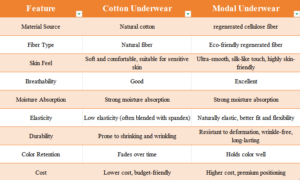In the underwear industry, as a close-fitting item, the choice of fabric is crucial. It not only determines the consumer’s wearing experience, but also directly affects the brand’s positioning. 20 years of experience in underwear manufacturing has made us deeply aware of the importance of fabrics. The skin-friendliness, breathability, elasticity, and density of a piece of fabric all affect the brand’s positioning invisibly. For a newly established underwear brand merchant, choosing what kind of fabric is a manifestation of the brand strategy. Cotton and modal, as the most common fabrics in the underwear industry, this article will take you to a deep understanding of the different advantages of pure cotton and modal underwear. Which one is more suitable for your brand?
The Basics of Cotton Underwear
Made of natural fibers from cotton plants, the porous structure of cotton fibers forms a natural “air channel”, which makes cotton underwear more breathable and is the best choice for hot and humid environments.
Cotton underwear is breathable and sweat-absorbent, because each gram of cotton fiber can absorb about 0.24 grams of water, far more than polyester.
And as a natural material with zero chemical additions, it is more suitable for skin prone to allergies. Because the production process only undergoes very little chemical treatment, it retains its natural characteristics and is very gentle on the skin.
Cotton fibers are biodegradable, which adds an environmental element to its application in textiles and has strategic value for brands with environmental protection requirements.
But cotton underwear also has shortcomings. Cotton has weak elasticity, so when making cotton underwear, some fabrics containing spandex are usually added to enhance the elasticity of the product.
The Basics of Modal Underwear
Modal is a wood pulp fiber extracted from European beech wood, made through advanced textile technology. It is a sustainable and environmentally friendly material, which makes Modal the first choice for users who pay attention to environmental protection.
Modal fiber fineness is only 1 dtex (cotton is 1.5-2.5 dtex), known as “breathing fiber”.
It has a silky smooth texture and a full sense of drape. It does not need to be ironed after washing. It is simply a blessing for lazy people.
For people who love sports, its rapid moisture absorption can keep the skin dry and not sticky.
In addition, after many washes, Modal still maintains its softness and color, bringing lasting comfort, making it an ideal choice for daily underwear. Its low allergenicity also makes it suitable for sensitive skin.
The relative weakness of Modal material is that the price will be slightly higher than cotton, and because its fiber structure is too soft, the finished underwear may have weak support and need to be used with other materials such as cotton or spandex.
Modal and cotton underwear comparison overview
Source of materials
Cotton: extracted from plants, pure natural material, with a long history and widespread use.
Modal: made from wood pulp fibers extracted from beech, a semi-synthetic fiberQ
Softness
Cotton: Although cotton is naturally soft, its softness will decrease with the number of washes.
Modal: The fiber is finer than cotton, and the fabric is softer. It is also widely loved because it feels as soft as silk.
Hygroscopicity
Cotton: Cotton has good hygroscopicity, but it is relatively slow to release moisture, especially during exercise, it tends to feel sticky when wet.
Modal: It absorbs moisture faster than cotton, especially suitable for high-intensity exercise, and can keep the skin dry at all times.
Breathability
Cotton: Cotton also has good breathability, but when the fabric is heavy and relatively thick, its breathability is not as good as modal.
Modal: Lightweight structure, breathability comparable to professional sports fabrics, can effectively regulate body temperature.
Shrinkage resistance
Cotton: Cotton underwear is easy to shrink and needs to be pre-shrunk
Modal: The shrinkage rate after washing is ≤2%, with strong shrinkage resistance. It can still maintain its original shape after multiple washings, and its stability is far superior to cotton.
Environmental protection
Cotton: Organic cotton is more sustainable, and traditional cotton cultivation requires a lot of land and water resources.
Modal: Low carbon emissions during production, generally considered more environmentally friendly
Cost-effectiveness
Cotton: Cotton is more affordable and suitable for basic products with high cost-effectiveness
Modal: Modal’s raw materials and craftsmanship are higher than cotton, suitable for mid-to-high-end products that want to increase product value.
Market acceptance
Cotton: It accounts for more than 50% of the market and is still the first choice for cost-effectiveness, but young people prefer to shift to technological fabrics.
Modal: It has a market share of 35% in sports and high-end underwear.
Fabric Comparison Table: Cotton vs Modal

Which fabric should you choose for your lingerie collection?
At this time, you need to determine your customer profile. What are your target user needs? What is your brand concept?
If your target is the mass market, price-sensitive, then cotton is cost-effective and more recognized by consumers.
If your target is the mid-to-high-end market or sports brand, pursuing high-quality user groups, and not sensitive to price, modal can provide a better comfortable underwear series.
In our factory, we provide cotton and modal fabric underwear manufacturing, and fully support OEM/ODM customization and low MOQ production, contact us to get samples.
FAQ
What is the difference between organic cotton and regular cotton?
The difference between organic cotton and ordinary cotton is mainly reflected in the planting method and the impact on the environment. Organic cotton does not use pesticides and fertilizers during the planting process. It is more natural and environmentally friendly, skin-friendly, especially suitable for infants and people with sensitive skin, and usually has authoritative certifications such as GOTS. In contrast, ordinary cotton uses traditional agricultural methods, with high yield and low cost, and is the mainstream choice of the mass market. Although organic cotton is relatively expensive, it represents a healthy and sustainable lifestyle and is more favored by consumers who pay attention to quality and environmental protection.
Conclusion
Whether it’s modal or cotton underwear, each has its own advantages and disadvantages. We make our choices based on our brand strategy and user base. This article will help you understand the differences between the two, which will surely help you choose which fabric to use in your underwear collection.



